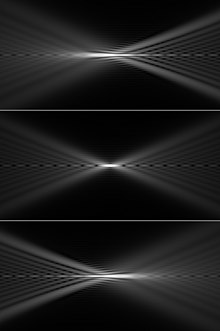 Originally posted by newarts
Originally posted by newarts 
The fstop to use to put everything behind the scene in focus is about the focal length (35 in this case) divided by the width of the scene in meters or yards.
For example a scene 5 yards (meters) wide would need
F= 35/5 = 7 so I'd use f:7 or f:8. For a scene 10 meters wide f:3.5 should be enough with your 35mm lens.
Try it.
Wonderful explanation -
focal length / scene width = aperture
35/5 = 7.0
35/6 = 5.8
35/7 = 5.0
35/8 = 4.4
35/9 = 3.9
35/10 = 3.5
35/20 = 1.8
35/30 = 1.2
35/40 = 0.9
35/50 = 0.7
The problem with this rule of thumb, is as you expand the scene width to infinity the aperture is driven to 0, when essentially it should logically run in the opposite direction.
However, the point I was trying to make is illustrated a bit better by sewebster .....
 Originally posted by sewebster
Originally posted by sewebster 
If I wanted to use this lens "hyperfocally" I'd calculate the hyperfocal distance for each f-stop of interest and either remember that or take the numbers with me. Then when setting up the shot I'd focus on something that I thought was further away than the specified value for my selected fstop (further in case I misestimated).
Personally I tend not to use hyperfocal much, because if I screw up I lose infinity sharpness, and in a lot of cases that is way more annoying than getting a bit more foreground DOF. It certainly can be used well though....
This is a scenario closer to where I was going. Without a distance scale on the lens or having the camera report it (which would just be more electronics to fail on the lens, with a more complex design to drive the price even higher), you are back to guesstimating everything with little or no input. Set f8, top the focus out at infinity and then back it off a smidge so as to pull more of the foreground in, and take the shot.
One easy and relatively inexpensive way to help here is to have DoF reported on the rear screen. This would be an easy software function to add with essentially near 0 cost. You have all the information - focal length, aperture and you can take a look at the object's distance you just focused on (while we still have our old fashion distance reported on the lens' barrel).
I am all for trying to keep the price of new lenses in the affordable range, however taking the basic information away from the user, does not necessarily help them to learn the "art" of photography, or develop as photographers. I am going to guess that 10 years from now, we will be talking about - way back when there were distance scales, and when the distance pin on the mount dies, you need to ........
 Originally posted by RioRico
Originally posted by RioRico 
Very soon, I shall list for sale a circa-1963 Voigtlander Bessamatic Deluxe film SLR with a Color-Skopar X 50/2.8 lens. Lenses for this type of camera have a curious DOF mechanism. As aperture (which is mechanically linked to shutter- and film-speed settings) is adjusted on the camera body, little pointers on the lens move across the distance markings, to indicate the DOF at any aperture and focus distance! A quick glance down at the lens thus reveals everything!
Now, this is an over-50-year-old design of a mechanical system, that is rather more informative than modern digital systems. Curious.
... and Rico - I like this concept. In terms of lenses, optics and mechanical internals are great. The only thing I really like about electronics in lenses, is the focal length and aperture reporting. Also, the mechanical screwdrive is wonderful. I still do not have a SDM lens.....
10 to 15 years from now the M42, K, M, A, FA and DA lenses will still be working. I think we will be living with the SDM lens failures and if only we could revert to screwdrive on these - particularly when the SDM motor goes Spaulding...

Last edited by interested_observer; 03-18-2011 at 07:10 PM.


 Similar Threads
Similar Threads 




















